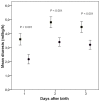Does parenteral nutrition influence electrolyte and fluid balance in preterm infants in the first days after birth?
- PMID: 20140260
- PMCID: PMC2815790
- DOI: 10.1371/journal.pone.0009033
Does parenteral nutrition influence electrolyte and fluid balance in preterm infants in the first days after birth?
Abstract
Background: New national guidelines recommend more restricted fluid intake and early initiation of total parenteral nutrition (TPN) in very preterm infants. The aim was study the effect of these guidelines on serum sodium and potassium levels and fluid balance in the first three days after birth.
Methods: Two cohorts of infants <28 weeks gestational age, born at the Leiden University Medical Center in the Netherlands, were compared retrospectively before (2002-2004, late-TPN) and after (2006-2007, early-TPN) introduction of the new Dutch guideline. Outcome measures were serum sodium and potassium levels, diuresis, and changes in body weight in the first three postnatal days.
Results: In the first three postnatal days no differences between late-TPN (N = 70) and early-TPN cohort (N = 73) in mean (SD) serum sodium (141.1 (3.8) vs 141.0 (3.7) mmol/l) or potassium (4.3 (0.5) vs 4.3 (0.5) mmol/l) were found, but in the early-TPN cohort diuresis (4.5 (1.6) vs 3.2 (1.4) ml/kg/h) and loss of body weight were decreased (-6.0% (7.7) vs -0.8% (8.0)).
Conclusions: Initiation of TPN immediately after birth and restricted fluid intake in very preterm infants do not seem to influence serum sodium and potassium levels in first three postnatal days. Further research is needed to see if a decreased diuresis and loss of body weight in the first days is the result of a delayed postnatal adaptation or better energy balance.
Conflict of interest statement
Figures


Similar articles
-
Standardized parenteral nutrition in preterm infants: early impact on fluid and electrolyte balance.Neonatology. 2010 Jun;98(1):84-90. doi: 10.1159/000276979. Epub 2010 Jan 21. Neonatology. 2010. PMID: 20090377 Clinical Trial.
-
Early vs late initiation of sodium glycerophosphate: Impact on hypophosphatemia in preterm infants <32 weeks.Clin Nutr. 2022 Feb;41(2):415-423. doi: 10.1016/j.clnu.2021.12.011. Epub 2021 Dec 10. Clin Nutr. 2022. PMID: 35007810
-
The effect of parenteral nitrogen and energy intake on electrolyte balance in the preterm infant.Eur J Clin Nutr. 2011 Oct;65(10):1088-93. doi: 10.1038/ejcn.2011.79. Epub 2011 May 18. Eur J Clin Nutr. 2011. PMID: 21587281
-
A physiological approach to fluid and electrolyte management of the preterm infant: Review.J Neonatal Perinatal Med. 2020;13(1):11-19. doi: 10.3233/NPM-190309. J Neonatal Perinatal Med. 2020. PMID: 31594261 Review.
-
Fluid and electrolyte intake during the first week of life in preterm infants receiving parenteral nutrition according current guidelines.Minerva Pediatr. 2010 Jun;62(3 Suppl 1):203-4. Minerva Pediatr. 2010. PMID: 21089742 Review.
Cited by
-
Early versus Late Parenteral Nutrition in Very Low Birthweight Neonates: A retrospective study from Oman.Sultan Qaboos Univ Med J. 2012 Feb;12(1):33-40. doi: 10.12816/0003085. Epub 2012 Feb 7. Sultan Qaboos Univ Med J. 2012. PMID: 22375256 Free PMC article.
-
Initial amino acid intake influences phosphorus and calcium homeostasis in preterm infants--it is time to change the composition of the early parenteral nutrition.PLoS One. 2013 Aug 15;8(8):e72880. doi: 10.1371/journal.pone.0072880. eCollection 2013. PLoS One. 2013. PMID: 23977367 Free PMC article.
-
Urinary metabolite profiles in premature infants show early postnatal metabolic adaptation and maturation.Nutrients. 2014 May 12;6(5):1913-30. doi: 10.3390/nu6051913. Nutrients. 2014. PMID: 24824288 Free PMC article. Clinical Trial.
-
Nutritional Intake Influences Zinc Levels in Preterm Newborns: An Observational Study.Nutrients. 2020 Feb 19;12(2):529. doi: 10.3390/nu12020529. Nutrients. 2020. PMID: 32093077 Free PMC article.
References
-
- Poindexter BB, Leitch CA, Denne SC. Nutrition and metabolism in the high-risk neonate; Part 2 Parenteral nutrition. In: Martin RJ, Fanaroff AA, Walsh MC, editors. Fanaroff and Martin's Neonatal-Perinatal Medicine. 8th ed. Philadelphia, Pa: Mosby; 2006. pp. 679–693.
-
- Te Braake FWJ, Van den Akker CHP, Riedijk MA, Van Goudoever JB. Parenteral amino acid and energy administration to premature infants in early life. Semin Fetal Neonatal Med. 2007;12:11–18. - PubMed
-
- Poindexter BB, Langer JC, Dusick AM, Ehrenkranz RA. Early provision of parenteral amino acids in extremely low birth weight infants: relation to growth and neurodevelopmental outcome. J Pediatr. 2006;148:300–305. - PubMed
-
- Bhatia J. Fluid and electrolyte management in the very low birth weight neonate. J Perinatol. 2006;26(Suppl 1):S19–21. - PubMed
-
- Puthoff TD. Fluids and electrolytes management. Newborn Infant Nurs Rev. 2004;4:98–105.
MeSH terms
Substances
LinkOut - more resources
Full Text Sources
Medical
Research Materials

